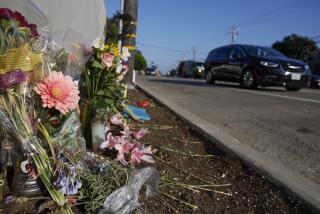Banal Buildings at Pepperdine Denature Its Glorious Location
- Share via
The banality of the Seaver College campus of Pepperdine University is overwhelming.
Set on the slopes of the Santa Monica Mountains as they flatten off into cliff-side meadows just north of Malibu, the campus is made up of yellowish-white stucco forms that give no clue of their purpose. Surmounted by red tile roofs that look like paste-ons and grouped around desolate concrete plazas, these buildings have all the grace of a suburban shopping development.
The buildings, like a suburban community, give back amenities in a kind of watered-down relationship to nature to replace what they take away with their monochromatic sameness. The 830-acre campus is surrounded by swimming pools, tennis courts, lawns, views of the ocean and, of course, the mountains--all of which are clipped and controlled and kept away from the heart of the campus.
Founded in 1937 and affiliated with the Churches of Christ, Pepperdine has promoted a clean, athletic image far removed from the complexities of Los Angeles. That image alone seems to preclude the kind of grand gestures for which the best American campuses are known. Universities from Harvard to USC have been designed as fortresses of learning. For better or worse, they are urban oases whose confident forms shape picturesque spaces within their domain.
Pepperdine’s glorious location has left it with little need to create such an image. Instead, architect William Pereira (who also designed the UC Irvine campus) in 1972 took his cues from the landscape, abstracting the slope of the site in triangular roof shapes. The red tile and stucco palette was meant as an abstraction of the Spanish Colonial architecture of houses such as the nearby Adamson Ranch, while the rambling placement of the central buildings was meant to create a defined, but not isolated heart for the campus. Unfortunately, the abstracted forms read as overwhelming, indistinguishable and unfocused building blocks of a set that never quite comes together.
Walking down Adamson Plaza, the main gathering spot for this community, you have no idea where you are, what the buildings around you house or which one is more important than the other. Dark glass set into black metal moldings help to further repel and mystify you. Inside such buildings as the Tyler Campus Center, things only become more banal, with institutional textures and neutral colors. Only occasional glimpses of the sea help relieve the monotony.
The only escape from the confines of this denatured architecture is the university chapel. Set at the western edge of the central campus, it is the face of Pepperdine and looks nothing like the other buildings. It is a parabolic arch with one end given over to a stained-glass window (blocking out views of the ocean), and it sits on a promontory overlooking a sweeping lawn, removed from the rest of the buildings.
Together with a memorial tower just to the south, it gives the suburban sprawl behind it an ecclesiastical face, however abstracted.
More recent buildings are, if possible, even worse than the original compound. The Charles B. Thornton Administrative Center, for instance, is a monolithic block that doesn’t have even the minimal sculpture of the original buildings to catch some echoes of the dramatic landscape.
Pepperdine wants to expand its campus, a desire that has caused considerable debate in the brand-new city of Malibu. I have no particular opinion on the development issues involved with this matter. However, I fear, based on what is already at the Seaver College campus, whatever this institution builds will further disfigure, rather than enhance, the landscape.
Aaron Betsky teaches and writes about architecture and urban design.
More to Read
Sign up for Essential California
The most important California stories and recommendations in your inbox every morning.
You may occasionally receive promotional content from the Los Angeles Times.













